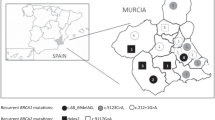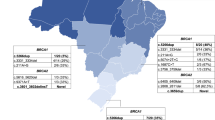Abstract
The prevalence of unique and recurrent BRCA1 and BRCA2 pathogenic mutations and unclassified variants varies among different populations. Two hundred and thirty-six breast and/or ovarian cancer patients were analysed to clarify the role of these genes in the Basque Country. We also studied 130 healthy women from the general population from the same region. Fifteen different pathological mutations were found in 16 index cases: 10 truncating mutations, 4 missense mutations and 1 splicing mutation. c.3002_3003insT and c.5788_5789delGT, both in exon 11 of BRCA2 have not previously been described. No pathological mutations were found in cases of sporadic juvenile breast cancer. There are no recurrent mutations in our population; apart from the mutation c.9254_9258del5, which appears in only two index cases. We have also found a lot of variants whose effect is unknown. From these variants, 17 have not previously been described: 6 missenses, 6 synonymous and 5 alterations in intronic regions. We would like to highlight the fact that 14.3% of patients with 3 or more cases of breast cancer in the family, and 16.7% of patients with family history of breast and ovarian cancer, present a pathological mutation in BRCA1 or BRCA2. This manuscript demonstrates that each population can have different mutations and due to this, Genetic Counselling and selection criteria must be different for each population. Furthermore, this article describes for the first time some new mutations and unclassified variants found in our population.

Similar content being viewed by others
References
Goldberg JI, Borgen JI (2006) Breast cancer susceptibility testing: past, present and future. Expert Rev Anticancer Ther 6(8):1205–1214
Miki Y, Swensen J, Shattuck-Eidens D et al (1994) A strong candidate for the breast and ovarian cancer susceptibility gene BRCA1. Science 266:66–71
Wooster R, Bignell G, Lancaster J et al (1995) Identification of the breast cancer susceptibility gene BRCA2. Nature 378:789–792
Goldgar DE, Easton DF, Deffenbaugh AM et al (2004) Integrated evaluation of DNA sequence variants of unknown clinical significance: application to BRCA1 and BRCA2. Am J Hum Genet 75:535–544
Wu K, Hinson SR, Ohashi A et al (2005) Functional evaluation and cancer risk assessment of BRCA2 unclassified variants. Cancer Res 65(2):417–426
Szabo CI, King MC (1997) Population genetics of BRCA1 and BRCA2. Am J Hum Genet 60:1013–1020
Martinez-Bouzas C, Beristain E, Guerra I et al (2006) CHEK2 1100delC is present in familial breast cancer cases of the Basque Country. Breast Cancer Res Treat. DOI 10.1007/s10549-0069351-4
Miller SA, Dykes DD, Polesky HF (1988) A simple salting out procedure for extracting DNA from human nucleated cells. Nucleic Acids Res 16(3):1215
Duran M, Esteban-Cardenosa E, Velasco E et al (2003) Mutational analysis of BRCA2 in Spanish breast cancer patients from Castilla-León: identification of four novel truncating mutations. Hum Mutat 21:448
Ganguly A, Rock MJ, Prockop DJ (1993) Conformation-sensitive gel electrophoresis for rapid detection of single-base differences in double-stranded PCR products and DNA fragments: evidence for solvent-induced bends in DNA heteroduplexes. Proc Natl Acad Sci 90:10325–10329
Tasonne F, Hagerman RJ, Chamberlain WD et al (2000) Transcription of the FMRN1 gene in individuals with fragile X syndrome. Am J Med Genet 97(3):195–203
Infante M, Durán M, Esteban-Cardeñosa E et al (2006) High proportion of novel mutations of BRCA1 and BRCA2 in breast cancer patients from Castilla-León (central Spain). J Hum Genet 51:611–617
Diez O, Osorio A, Durán M et al (2003) Analysis of BRCA1 and BRCA2 genes in Spanish breast/ovarian cancer patients: a high proportion of mutations unique to Spain and evidence of founder effects. Hum Mutat 22:301–312
Giannini G, Capalbo C, Ristori E et al (2006) Novel BRCA1 and BRCA2 germline mutations and assessment of mutation spectrum and prevalence in Italian breast and/or ovarian cancer families. Breast Cancer Res Treat 100(1):83–91
Salazar R, Cruz-Hernández JJ, Sanchez-Valdivieso E et al (2006) BRCA1-2 mutations in breast cancer: identification of nine new variants of BRCA1-2 genes in a population from central Western Spain. Cancer Lett 233:172–177
de la Hoya M, Osorio A, Godino J et al (2002) Association between BRCA1 and BRCA2 mutations and cancer phenotype in Spanish breast/ovarian cancer families: implications for genetic testing. Int J Cancer 97:466–471
Campos B, Diez O, Odefrey F et al (2003) Haplotype analysis of the BRCA2 9254delATCAT recurrent mutation in breast/ovarian cancer families from Spain. Hum Mutat 21(4):452–457
Campos B, Diez O, Domènech M et al (2003) RNA analysis of eight BRCA1 and BRCA2 unclassified variants identified in breast/ovarian cancer families from Spain. Hum Mutat 22(4):337
Brzovic PS, Keeffe JR, Nishikawa H et al (2003) Binding and recognition in the assembly of an active BRCA1/BARD1 ubiquitin–ligase complex. PNAS 100(10):5646–5651
Osorio A, de la Hoya M, Rodriguez-Lopez R et al (2002) Loss of heterozygosity analysis at the BRCA loci in tumor samples from patients with familial breast cancer. Int J Cancer 99:305–309
Mirkovic N, Marti-Renom MA, Weber BL et al (2004) Structure-based assessment of missense mutations in human BRCA1: implications for breast and ovarian cancer predisposition. Cancer Res 64:3790–3797
Wong JMS, Ionescu D, Ingles CJ (2003) Interaction between BRCA2 and replication protein A is compromised by a cancer-predisposing mutation in BRCA2. Oncogene 22:28–33
Mazoyer S, Dunning AM, Serova O et al (1996) A polymorphic stop codon in BRCA2. Nat Genet 14:253–254
Martin ST, Matsubayashi H, Rogers CD et al (2005) Increased prevalence of the BRCA2 polymorphic stop codon K3326X among individuals with familial pancreatic cancer. Oncogene 24:3652–3656
Cartegni L, Wang J, Zhu Z et al (2003) ESEfinder: a web resource to identify exonic splicing enhancers. Nucleic Acids Res 31(13):3568–3571
Baumbach L, Gayol L, Monteiro A et al (2004) BRCA1/BRCA2 missense mutations in African-American breast cancer patients. Paper presented at the 2004 miami nature biotechnology winter symposium, the Cell Cycle, chromosomes and cancer, University of Miami, Miami, Florida, USA, 31 Jan–4 Feb 2004
Edwards SM, Kote-jarai Z, Meitz J et al (2003) Two percent of men with early-onset prostate cancer harbor germline mutations in the BRCA2 gene. Am J Hum Genet 72:1–12
Claes K, Poppe B, Machackova E et al (2003) Differentiating pathogenic mutations from polymorphic alterations in the splice sites of BRCA1 and BRCA2. Genes Chromosomes Cancer 37(3):314–320
Grudinina NA, Golubkov VI, Tikhomirova OS et al (2005) Prevalence of widespread BRCA1 gene mutations in patients with familial breast cancer from St. Petersburg. Genetika 41(3):405–410
Acknowledgements
This project was financially supported by Grants 200112034 and 200311027 from the Health Department of the Basque Country Goverment. We are indebted to patients for participating in this study.
Author information
Authors and Affiliations
Corresponding author
Rights and permissions
About this article
Cite this article
Beristain, E., Martínez-Bouzas, C., Guerra, I. et al. Differences in the frequency and distribution of BRCA1 and BRCA2 mutations in breast/ovarian cancer cases from the Basque country with respect to the Spanish population: implications for genetic counselling. Breast Cancer Res Treat 106, 255–262 (2007). https://doi.org/10.1007/s10549-006-9489-0
Received:
Accepted:
Published:
Issue Date:
DOI: https://doi.org/10.1007/s10549-006-9489-0




